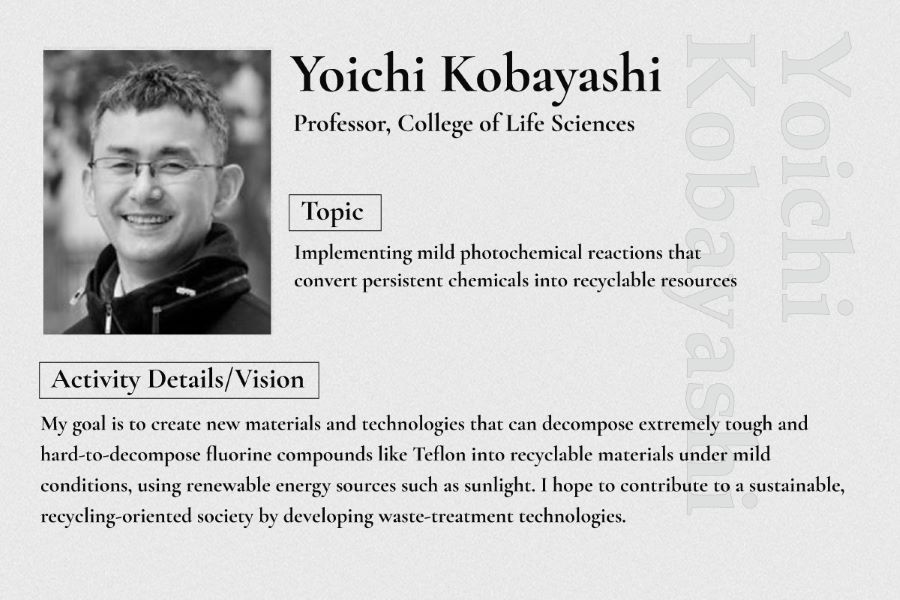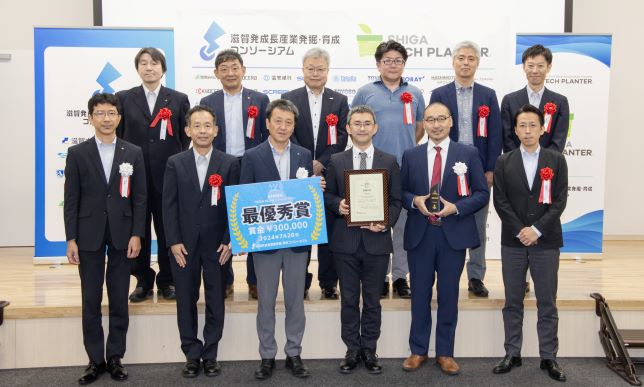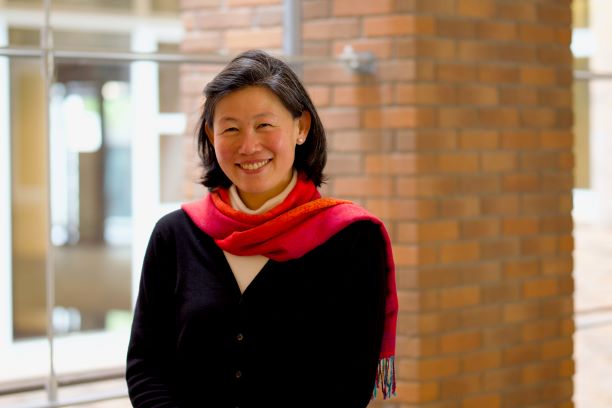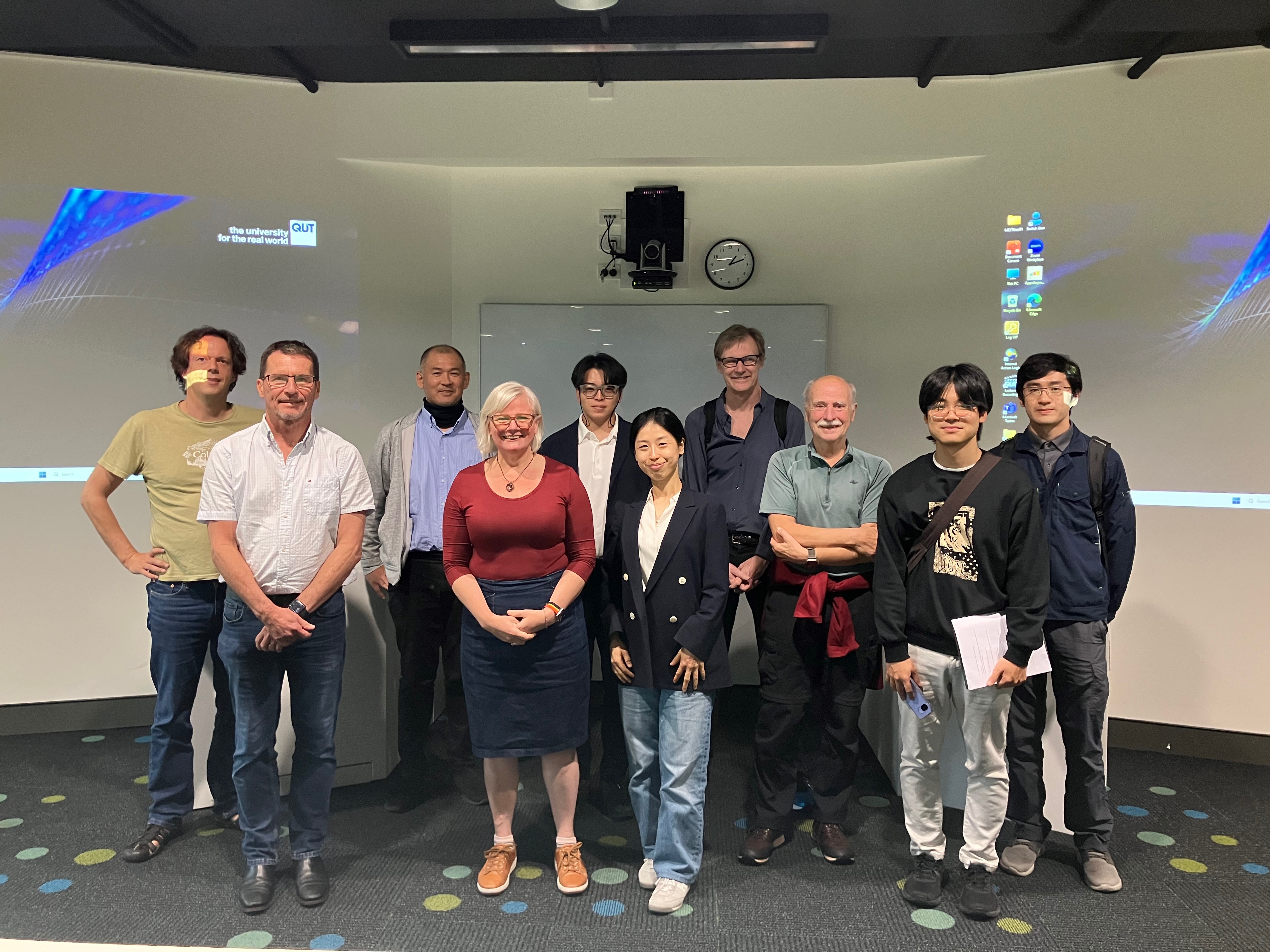Newsletter / Research Activity Report / Yoichi Kobayashi
RARA Newsletter vol. 10 Interview with RARA Associate Fellow Professor Yoichi Kobayashi: Successfully Decomposing “PFAS,” Known as Forever Chemicals, and the Desire to Contribute to Society
2025 / 11 / 19

2025 / 11 / 19
Using Photochemical Reactions to Convert PFAS, the Forever Chemicals, into Recycling Resources
This Newsletter features an interview with RARA Associate Fellow Yoichi Kobayashi, a Professor at the College of Life Sciences.

Professor Kobayashi specializes in the study of functional materials utilizing light. In particular, his research aims to use light to decompose per- and polyfluoroalkyl substances (PFAS), which are called “forever chemicals,” and has attracted attention as having the potential to contribute to environmental protection by facilitating the advancement of recycling technology.
PFAS is the general term for perfluoroalkyl and polyfluoroalkyl substances, a group of organic fluorine compounds. They have excellent water and oil repellency and are widely used in both industrial and everyday products, such as fluorine processing agents for frying pans, wrapping paper for food, waterproofing and stain-resistant sprays, and surface treatment agents for semiconductors.
However, PFAS is extremely difficult to break down and cause water pollution and environmental issues. Therefore, establishing a method for their decomposition is a crucial step toward the realization of a sustainable society.
Winning the Shiga Tech Plan Grand Prix and Making Progress Toward Practical Use
In July 2024, Prof. Kobayashi’s team won the top prize and two other awards at the 9th Shiga Tech Plan Grand Prix for their research on “Carrying out mild photochemical reactions that turn forever chemicals into recyclable resources.” The research was highly evaluated as marking an important step toward practical application.

What drives Prof. Kobayashi’s research activities? How was the moment forever chemicals were successfully decomposed using light for the first time? We explored these questions in the interview with Prof. Kobayashi.
(The following is a summary of the conversation with Prof. Kobayashi.)
Decomposition and Recycling of Forever Chemicals Under Mild Conditions Made Possible with the Use of Multiple Lights
I am conducting research on functional materials using light and I aim to successfully break down substances which are difficult to decompose, in particular PFAS, fluorinated hydrocarbon compounds.
By irradiating semiconductor nanocrystals with multiple photons, we can synthesize reducing substances which possess high reactivity even under mild conditions. We are utilizing this approach to advance research on the decomposition of substances which do not easily break down.
Although PFAS are small molecules, they have emerged as a serious issue in Japan and abroad, contributing to freshwater and marine pollution, necessitating the use of filters for removal. They require high temperatures and pressure for decomposition, rendering them challenging to manage from a technical standpoint. Materials containing fluorine have found use in multiple fields. For example, they are used in Teflon, a material used in frying pans and car bodies, and batteries. The difficulty of decomposing these items is an issue.

Through my research, I believe that establishing technology that can decompose fluorinated materials under mild conditions will contribute to the advancement of recycling technology.
Furthermore, as Japan is currently dependent on foreign countries for almost all of our raw fluorine, I believe achieving fluorine recycling will increase our fluorine self-sufficiency rate and become a technology that supports a prosperous, recycling-oriented society.
Exploring Complex Mechanisms Using “Spectroscopic Analysis”
A uniqueness of my research is that it is based on inorganic materials, such as semiconductors, but at the same time handles composite materials of inorganic and organic materials. The reactions that occur when a composite material is irradiated with light are very complex, but I believe the novelty of my research lies in my use of spectroscopic analysis techniques to explore and elucidate these mechanisms.
Let me explain organic and inorganic composite materials and light-based technologies in greater depth.
Most researchers working with semiconductor materials work in the field of physics, while researchers working on organic compounds work in chemistry. The semiconductor nanocrystals and composite organic matter that I use lie on the boundary between the two fields. These materials are considered difficult to approach due to the extremely complex reactions that occur.
I believe I am capable of challenging these complex systems because I can approach complex phenomena via spectroscopic analysis using laser and other technologies. Spectroscopic analysis is a way to analyze matter by classifying the light it emits and absorbs into wavelengths and isolating the wavelengths (spectrum) specific to its constituent molecules.
In my research, I focus on composite materials made of inorganic and organic materials and conduct spectroscopic analysis of the reactions that occur when irradiated. This approach allows me to clarify their mechanisms.
In photochemical reactions, for example, one-to-one reactions akin to the collision of billiard balls are common. However, when it comes to nanocrystalline semiconductors, we are likely to see nonlinear reactions where a photon collides with a state created by a photon, producing one reaction. This reaction is the key to our technology.

A Strong Desire to Contribute to Society. Findings from Fundamental Research
The starting point of my research was to clarify why special optical functions arise only from certain semiconductor nanocrystal substances, that is, an exploration of purely academic interests. I was immersed in researching physical properties using ultrashort pulse lasers (strobe-like light with extremely short exposure time and brightness) that can visualize phenomena at 1/1013 of a second. I felt that I was revealing special phenomena of semiconductor nanocrystals that cannot be observed normally, which I found very fulfilling.
In my pursuit of studying high-speed phenomena distinct from visible time, I began to consider how such fundamental research can contribute to society.
I became interested in materials that changed color when exposed to light, a phenomenon known as “photochromism.” Although it was a completely different field from my research at the time, I jumped into it.
In this field, substances created through fundamental research had the potential to be developed into materials that can be widely used in society, such as glasses that turn into sunglasses when outdoors, and fashion materials that change color. I realized the appeal and significance of contributing to society through fundamental research. Looking at the current social situation, I began to consider whether I could contribute to society through research addressing the fundamental problems humans face, such as energy and the environment.
The phenomenon of changing color due to light indicates that the state of a material changes as light provides energy to it. In pursuing this, it occurred to me that if we could create a slightly higher energy state using light, and if that state was stable for a long duration, then exposing that state to more light could create a higher energy state. It is like Super Mario making a “double jump” in a video game to jump to a greater height.
“This Should Break it Down.” A Joyous Moment and Big Advancement
While looking at spectrometry data, we discovered a phenomenon where very powerful reducing agents were produced in a process similar to a double jump. We found that even substances that cannot be decomposed using ordinary visible light, such as sunlight, could be decomposed using this “double jump,” and that energy equivalent to ultraviolet light could be generated by visible light. We were convinced that fluorine compounds could also be decomposed with this approach, so we experimented with PFAS and found that it was successfully decomposed.
It was a joyous moment, and I cheered with my students in the laboratory. The students were skeptical at the beginning as no change was observed in the first hour, but when we left it for a little longer, the reaction gradually peaked and we were all excited. It was a big step.

Photoreaction Evaluation System
This discovery was made over 2 years ago, but the principles were established and results summarized only very recently. This discovery triggered a shift in our research to focus on the decomposition of persistent hazardous substances such as PFAS.
Challenges in the Practical Use of Fluorine Recycling
To me, it is like we have another card to play in the research of “fluorine decomposition technology.” Two years have passed since its discovery, and the capabilities of this technology are being clarified.
Although the removal of PFAS may only require a small amount of decomposition, Japan imports 30,000 tons of fluorine annually, and recycling even 1% of it will require the treatment of about 30 tons. This technology alone is not expected to significantly change the world, and I think we need to combine different technologies to overcome some of the challenges.
Clarifying the Reaction Mechanisms of Inorganic Surfaces using Spectrum
This might be an enthusiast’s perspective, but I think it is interesting that organic substances must come into contact with the surface of semiconductors, which are inorganic substances, to create a reaction. Various organic molecules are found on surfaces of inorganic matter, and it has become clear that exposure to light changes those molecules dynamically, temporarily opening up the space necessary for a reaction. This phenomenon leads to a cycle of decomposition reactions.
It is essential to understand this cycle, and many aspects of the surface reactions of inorganic substances have yet to be fully explained. My research not only seeks to develop methods for the decomposition of fluorine, but also to clarify and control reaction mechanisms on inorganic surfaces.
Little research has been conducted to observe dynamically changing surfaces. My novel technique of spectrometry and analysis using pulsed lasers enables the analysis of data as predictive data on a time axis. This allows the capture of previously unobserved dynamic reactions as data.

Spectrometer using Ultrashort Pulse Lasers
Although the data obtained from images are intuitive, we can only track up to the speed at which the eye can see. Therefore, there are limits to this approach, as the speed at which molecules break and combine is very fast.
This is why we observe it via a method known as “spectrum” (which I often refer to as “looking”). This method involves attempting to perceive phenomena indirectly without our eyes, similar to putting your hand in an invisible box and feeling around. This spectrum can be measured using ultrashort pulsed light to track fast binding changes of molecules.
Looking through the spectrum reveals extremely minute changes in molecules. For example, we can see the time at which the bonds of a molecule weaken slightly and the subtle differences in the reaction rate of another molecule. From our analysis, based on the information obtained through these changes in the spectrum, we can infer, for example, that “this molecule is separating.”
Challenges and Possibilities of AI Analysis and Working on “Chemical Recycling” with Companies
We have begun using AI and statistical analysis to explore new materials. We are working with the AI departments of companies to parameterize the composition and conditions of materials. We hope these initiatives will be helpful for material development in the future.
The majority of the experimental data we have generated to date has been produced under conditions that we believed to be effective, and does not include much data from failures or unexpected data. Therefore, I believe we need to increase the diversity of our data.
More specifically, AI analysis can only consider data within set optimized conditions, such as conditions A, B, and C. Given this, it is difficult to get unexpected data, as we are only experimenting in the range that we anticipate will work. To address this, we now believe we need to try conditions at random and statistically analyze data.
To this end, we are developing a device that can evaluate multiple photoreactions simultaneously. This should greatly reduce the time required for evaluation and significantly increase the variety of experiments.
Collaborations within and outside the University
My strength is analyzing, rather than synthesizing materials. Therefore, I often ask experts in creating materials to provide me with them, and we often work together to explore what can be done with them.
We receive proposals from professors at other universities for research collaboration on materials they have synthesized, and we also reach out to ask for materials. We have published research results with professors from other universities and we are accumulating successful results.
Regarding collaboration within the University, I have been collaborating with RARA Fellow Professor Hiromitsu Maeda of the Department of Applied Chemistry, College of Life Sciences, for several years on fundamental research on organic molecules, and we have co-authored several papers.
Scaling up Deployment for Recycling Technology and Social Implementation
My vision for the future is to spread awareness of this technology to as many people as possible. By connecting with numerous people and expanding the potential of this technology, I aim to open up new possibilities to develop novel recycling technologies and implement them in society. Businesses are highly interested and active in this field.
In this respect, I believe scaling up presents the biggest challenge. Once the underlying technical issues have been solved, we can discuss how to use the products after decomposition. At this stage, we want to develop a purification device that can be used in the plants of various companies, rather than wide application at the local governmental level.
Currently, after using fluorine, many companies outsource the collection of liquid and other waste to recyclers. However, the ideal mechanism would be one where it is broken down in-house and the fluorine extracted provided or sold to material manufacturers. I want to streamline this process and solve the issues associated with installing equipment in corporate plants.
In terms of specific plans for the future, I think it is important to first spread knowledge of the technology among as wide a group of people as possible so that we can identify where the technology can be applied. Once we have achieved the desired level of efficiency discussed with companies, we plan to run simulations to determine the scale at which this can be profitable. To this end, we first need to accumulate fundamental data as well as conducting applied research.
Valuing One’s Interests and Passions and Enjoying Research
What I want young people to understand is that their interests and passions are important. Before and during my freshman year of college, I was interested in environmental issues and tried to read books on environmental science on two occasions, but they were full of laws and regulations and jargon, so I immediately closed them.
Nevertheless, I liked chemistry and physics, and the knowledge and skills I learned as I studied and advanced in these subjects led me to make contributions to the environment and society. Now, when I read books on environmental science, I am able to grasp the laws and regulations that I did not understand back then as if they were my own issues.
In research, it is important to pursue your interests and value your actions. It is not simply about being the best at something, the process you undergo is also important. I think research is an extremely attractive initiative that allows you to make full use of your own perspective. I hope everyone will find such interest in research.




